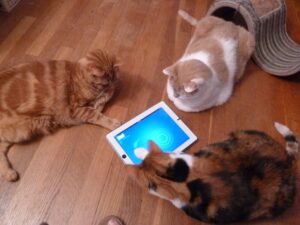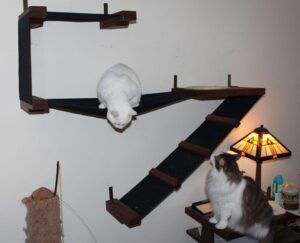The Vet is In:
Keeping Indoor Cats Stimulated and Happy
Those of us who share our lives and homes with cats know that:
- Cats are NOT just small dogs — they are very different animals.
- Cats bond with their surrounding “territory” (which includes their humans) rather than with their “pack”; thus, most dislike car rides and travel to new venues, while dogs are thrilled not to be left behind by their humans and are eager for new adventures.
- Cats are superior predators and will roam widely in pursuit of their “game.” Even when well-fed, cats will spend their outdoor hours stalking rodents, insects, and birds with devastating impacts on bird populations which already struggle for survival in the 21st century’s housing sprawls, toxic environments, and loss of open spaces.

As birds’ numbers decline dramatically, conservationists beg cat owners to keep their cats inside, while cat lovers want their companion to enjoy the outdoors; they deny that their cat has any real effect on population numbers, blaming the dwindling numbers of birds on loss of habitat, collisions with motor vehicles, toxic environments, manufacturing, etc., all of which are additional factors that drive avian population numbers down. The American Bird Conservancy (abcbirds.org) states that the over one hundred million feral and outdoor cats in the USA are responsible for the deaths of 2.4 billion birds annually. Their website contains information on bird species driven to near-extinction by cat predation, and begs us to stop creating TNR (Trap, Neuter, Return) programs that encourage more predation and loss of wildlife.

NYSHA encourages cat owners to keep their cats inside so there is no risk of their succumbing to motor vehicles or cruel humans. Following Ohio State University’s “Indoor Pet Initiative,” we can protect our cats from dangers in the outside world and still have a happy and satisfied feline. Their website (indoorpet.osu.edu/cats) gives sound advice on litter box placement and environmental enrichment for house-bound cats: for example, whereas dogs and humans live in two dimensions (length and width,) cats live in three — adding height. Cats are eager to have areas in which they can observe their world from above. The perfect design is to have a kitty-climbing perch/tower by a picture window with bird feeders attracting entertainment on the wing.
If your house is suitable, a small enclosed “kitty porch” or catio could be constructed, with access from a door or window. Also, rather than feeding meals in a dish, try putting dry diet pieces in a feeding toy that the cat must pursue and swat to get his or her meal — the thrill of the chase! Have appropriately placed soft beds in various locations that your cat finds appealing, and provide agreed-upon scratching locations and materials for their marking instincts. Don’t forget to introduce new toys, once your cat indicates his/her preferences. The wild birds need our help.
 Please spread the word!
Please spread the word!
Holly Cheever, DVM
NYSHA’s VP, Dr. Holly Cheever, is a partner in a small animal practice, the Village Animal Clinic, in Voorheesville, NY. She sits on several boards for animal issues, is a speaker and consultant across the nation, and has testified before Congress about animal abuse in circuses, as well as in New York City regarding the carriage horse trade.
New York State Humane Association Humane Review, Vol.XXXVI, Fall 2020.